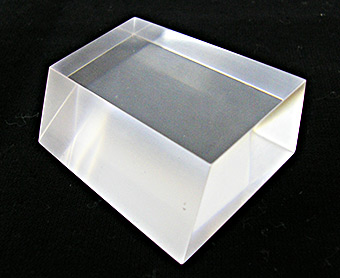Thallium doped Sodium Iodide NaI(Tl)
Single crystal sodium iodide doped with thallium ions is a classic scintillator for detecting gamma-radiation of intermediate and low energies. High luminescence efficiency, wide variety of sizes and geometries and relatively low-cost make NaI(Tl) the most widely used scintillator.
NaI(Tl) scintillators have the greatest light output among all the scintillators and a convenient emission range coinciding with a maximum efficiency of photomultipliers with bialkali photocathodes.
NaI(Tl) crystals have radiation hardness that is quite satisfactory for many applications. They can be used under γ-radiation with flux density of up to 105 photons/(s*cm2) without any noticeable variation of their characteristics.

A serious drawback of NaI(Tl) scintillators is their high hygroscopicity, due to which these crystals must be placed into hermetically sealed housing (container).
Wide application of NaI(Tl) crystals is mainly due to relative simplicity of using and low cost of crystals. Because of favorable combination of physical properties, NaI(Tl) scintillators are widely used in different detecting systems in radiation medicine, in apparatus for monitoring of radionuclides, in nuclear physics, high energy physics, etc.
NaI(Tl) Polycrystalline Scintillators
Alongside NaI(Tl) single crystals, Amcrys produces pressed polycrystalline scintillators which have higher temperature and mechanical stability at the same light yield. NaI(Tl) polycrystals are used in outer space studies, for gamma-ray logging in gas and oil industry, in radiation environmental monitoring, etc. Polycrystals can be easily shaped into any desired form and any size. A long NaI(Tl) polycrystals can be used as a position-sensitive detectors with good spectrometric characteristics.
NaI(Tl) polycrystal plates are used for production of imaging detectors for tomographic medical imaging systems.
- Additional information and features:
- Markets and applications
- Available dimensions
- Related documents
- high light output
- single crystal or polycrystalline form
- good matching of the radioluminescence spectrum to the maximum sensitivity region of the commonly used PMT and fast response
- high mechanical hardness characteristics (only for the polycrystalline)
Environmental monitoring – gamma-radiation monitoring
Security control – passive portal monitors, x-ray scanning systems, radiation isotope identification devices
Geophysics – well-logging, aerial survey
Industrial – health physics, neutron activation analysis, non-destructive testing (defectoscopy)
HEP and Astrophysics
Rectangular form: up to 500 mm long
Plates (only for the NaI(Tl) polycrystals): 593 mm long x 470 mm wide, and up to 450 mm in diameter